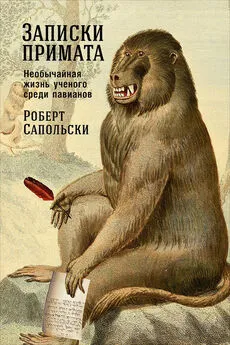Роберт Сапольски - Биология добра и зла. Как наука объясняет наши поступки
- Название:Биология добра и зла. Как наука объясняет наши поступки
- Автор:
- Жанр:
- Издательство:Альпина нон-фикшн
- Год:2019
- Город:Москва
- ISBN:978-5-0013-9051-0
- Рейтинг:
- Избранное:Добавить в избранное
-
Отзывы:
-
Ваша оценка:
Роберт Сапольски - Биология добра и зла. Как наука объясняет наши поступки краткое содержание
Биология добра и зла. Как наука объясняет наши поступки - читать онлайн бесплатно ознакомительный отрывок
Интервал:
Закладка:
182
A. Dixson and J. Herbert, “Testosterone, Aggressive Behavior and Dominance Rank in Captive Adult Male Talapoin Monkeys ( Miopithecus talapoin ),” Physiology & Behav 18 (1977): 539.
183
E. Hermans et al., “Exogenous Testosterone Enhances Responsiveness to Social Threat in the Neural Circuitry of Social Aggression in Humans,” BP 63 (2008): 263; J. van Honk et al., “A Single Administration of Testosterone Induces Cardiac Accelerative Responses to Angry Faces in Healthy Young Women,” Behav Nsci 115 (2001): 238; R. Ronay and A. Galinsky, “ Lex Talionis : Testosterone and the Law of Retaliation,” JESP 47 (2011): 702; P. Mehta and J. Beer, “Neural Mechanisms of the Testosterone-Aggression Relation: The Role of Orbitofrontal Cortex,” J Cog Nsci 22 (2010): 2357; P. Bos et al., “Testosterone Decreases Trust in Socially Naïve Humans,” PNAS 107 (2010): 9991.
184
K. Kendrick and R. Drewett, “Testosterone Reduces Refractory Period of Stria Terminalis Neurons in the Rat Brain,” Sci 204 (1979): 877; K. Kendrick, “Inputs to Testosterone-Sensitive Stria Terminalis Neurones in the Rat Brain and the Effects of Castration,” J Physiology 323 (1982): 437; K. Kendrick, “The Effect of Castration on Stria Terminalis Neurone Absolute Refractory Periods Using Different Antidromic Stimulation Loci,” Brain Res 248 (1982): 174; K. Kendrick, “Electrophysiological Effects of Testosterone on the Medial Preoptic-Anterior Hypothalamus of the Rat,” J Endo 96 (1983): 35; E. Hermans et al., “Exogenous Testosterone Enhances Responsiveness to Social Threat in the Neural Circuitry of Social Aggression in Humans,” BP 63 (2008): 263.
185
J. Wingfield et al., “The ‘Challenge Hypothesis’: Theoretical Implications for Patterns of Testosterone Secretion, Mating Systems, and Breeding Strategies,” Am Naturalist 136 (1990): 829.
186
J. Archer, “Sex Differences in Aggression in Real-World Settings: A Meta-analytic Review,” Rev of General Psych 8 (2004): 291.
187
J. Wingfield et al., “Avoiding the ‘Costs’ of Testosterone: Ecological Bases of Hormone-Behavior Interactions,” Brain, Behav and Evolution 57 (2001): 239; M. Sobolewski et al., “Female Parity, Male Aggression, and the Challenge Hypothesis in Wild Chimpanzees,” Primates 54 (2013): 81; R. Sapolsky, “The Physiology of Dominance in Stable Versus Unstable Social Hierarchies,” in Primate Social Conflict , ed. W. Mason and S. Mendoza (New York: SUNY Press, 1993), p. 171. P. Bernhardt et al., “Testosterone Changes During Vicarious Experiences of Winning and Losing Among Fans at Sporting Events,” Physiology & Behav 65 (1998): 59.
188
M. Muller and R. Wrangham, “Dominance, Aggression and Testosterone in Wild Chimpanzees: A Test of the ‘Challenge’ Hypothesis,” Animal Behav 67 (2004): 113; J. Archer, “Testosterone and Human Aggression: An Evaluation of the Challenge Hypothesis,” Nsci Biobehav Rev 30 (2006): 319.
189
К сноске: L. Gettler et al., “Longitudinal Evidence That Fatherhood Decreases Testosterone in Human Males,” PNAS 108 (2011): 16194. S. Van Anders et al., “Baby Cries and Nurturance Affect Testosterone in Men,” Horm Behav 61 (2012): 31. J. Mascaro et al., “Testicular Volume is Inversely Correlated with Nurturing-Related Brain Activity in Human Fathers,” PNAS 110 (2013): 15746. У некоторых приматов время выполнения ряда отцовских обязанностей совпадает со временем соревнования самцов, должного улучшить их шансы на репродуктивный успех. В гормональном плане все усложняется, т. к. отцовство и соревновательность прямо противоположным образом влияют на уровень тестостерона. По данным одного исследования, зов чресел оказался сильнее отцовского порыва и уровень тестостерона повысился. P. Onyango et al., “Testosterone Positively Associated with Both Male Mating Effort and Paternal Behavior in Savanna Baboons ( Papio cynocephalus ),” Horm Behav 63 (2012): 430.
190
J. Higley et al., “CSF Testosterone and 5-HIAA Correlate with Different Types of Aggressive Behaviors,” BP 40 (1996): 1067.9781594205071_Behave_TX.indd 731 3/16/17 9:12 AM
191
C. Eisenegger et al., “Prejudice and Truth About the Effect of Testosterone on Human Bargaining Behaviour,” Nat 463 (2010): 356.
192
M. Wibral et al., “Testosterone Administration Reduces Lying in Men,” PLoS ONE 7 (2012): e46774.Также см.: J. Van Honk et al., “New Evidence on Testosterone and Cooperation,” Nat 485 (2012): E4.
193
Некоторые обзоры: O. Bosch and I. Neumann, “Both Oxytocin and Vasopressin Are Mediators of Maternal Care and Aggression in Rodents: From Central Release to Sites of Action,” Horm Behav 61 (2012): 293; R. Feldman, “Oxytocin and Social Affiliation in Humans,” Horm Behav 61 (2012): 380; A. Marsh et al., “The Influence of Oxytocin Administration on Responses to Infant Faces and Potential Moderation by OXTR Genotype,” Psychopharmacology (Berlin) 24 (2012): 469; M. J. Bakermans-Kranenburg and M. H. van Ijzendoorn, “Oxytocin Receptor (OXTR) and Serotonin Transporter (5-HTT) Genes Associated with Observed Parenting,” SCAN 3 (2008): 128. Гипоталамический путь, который зависит от пола: N. Scott et al., “A Sexually Dimorphic Hypothalamic Circuit Controls Maternal Care and Oxytocin Secretion,” Nat 525 (2016): 519.
194
К сноске: D. Huber et al., “Vasopressin and Oxytocin Excite Distinct Neuronal Populations in the Central Amygdala,” Sci 308 (2005): 245; D. Viviani and R. Stoop, “Opposite Effects of Oxytocin and Vasopressin on the Emotional Expression of the Fear Response,” Prog Brain Res 170 (2008): 207.
195
Y. Kozorovitskiy et al., “Fatherhood Affects Dendritic Spines and Vasopressin V1a Receptors in the Primate Prefrontal Cortex,” Nat Nsci 9 (2006): 1094; Z. Wang et al., “Role of Septal Vasopressin Innervation in Paternal Behavior in Prairie Voles,” PNAS 91 (1994): 400.
196
A. Smith et al., “Manipulation of the Oxytocin System Alters Social Behavior and Attraction in Pair-Bonding Primates, Callithrix penicillata ,” Horm Behav 57 (2010): 255; M. Jarcho et al., “Intransal VP Affects Pair Bonding and Peripheral Gene Expression in Male Callicebus cupreus ,” Genes, Brain and Behav 10 (2011): 375; C. Snowdon, “Variation in Oxytocin Is Related to Variation in Affiliative Behavior in Monogamous, Pairbonded Tamarins,” Horm Behav 58 (2010); 614.
197
Z. Donaldson and L. Young, “Oxytocin, Vasopressin, and the Neurogenetics of Sociality,” Sci 322 (2008): 900; E. Hammock and L. Young, “Microsatellite Instability Generates Diversity in Brain and Sociobehavioral Traits,” Sci 308 (2005): 1630; L. Young et al., “Increased Affiliative Response to Vasopressin in Mice Expressing the V1a Receptor from a Monogamous Vole,” Nat 400 (1999): 766; M. Lim et al., “Enhanced Partner Preference in a Promiscuous Species by Manipulating the Expression of a Single Gene,” Nat 429 (2004): 754.
198
E. Hammock and L. Young, “Microsatellite Instability Generates Diversity in Brain and Sociobehavioral Traits,” Sci 308 (2005): 1630.
199
I. Schneiderman et al., “Oxytocin at the First Stages of Romantic Attachment: Relations to Couples’ Interactive Reciprocity,” PNE 37 (2012): 1277.
200
B. Ditzen et al., “Intranasal Oxytocin Increases Positive Communication and Reduces Cortisol Levels During Couple Conflict,” BP 65 (2009): 728; D. Scheele et al., “Oxytocin Modulates Social Distance Between Males and Females,” J Nsci 32 (2012): 16074; H. Walum et al., “Genetic Variation in the Vasopressin Receptor 1a Gene Associates with Pair-Bonding Behavior in Humans,” PNAS 105 (2008): 14153; H. Walum et al., “Variation in the Oxytocin Receptor Gene Is Associated with Pair-Bonding and Social Behavior,” BP 71 (2012): 419.
201
M. Nagasawa et al., “Oxytocin-Gaze Positive Loop and the Coevolution of Human-Dog Bonds,” Sci 348 (2015): 333.
202
M. Yoshida, et al., “Evidence That Oxytocin Exerts Anxiolytic Effects via Oxytocin Receptor Expressed in Serotonergic Neurons in Mice,” J Nsci 29 (2009): 2259. Работа окситоцина в миндалине: D. Viviani et al., “Oxytocin Selectively Gates Fear Responses Through Distinct Outputs from the Central Nucleus,” Sci 333 (2011): 104; H. Knobloch et al., “Evoked Axonal Oxytocin Release in the Central Amygdala Attenuates Fear Response,” Neuron 73 (2012): 553; S. Rodrigues et al., “Oxytocin Receptor Genetic Variation Relates to Empathy and Stress Reactivity in Humans,” PNAS 106 (2009): 21437; M. Bakermans-Kranenburg and M. van Ijzendoorn, “Oxytocin Receptor (OXTR) and Serotonin Transporter (5-HTT) Genes Associated with Observed Parenting,” SCAN 3 (2008): 128; G. Domes et al., “Oxytocin Attenuates Amygdala Responses to Emotional Faces Regardless of Valence,” BP 62 (2007):1187; P. Kirsch, “Oxytocin Modulates Neural Circuitry for Social Cognition and Fear in Humans,” J Nsci 25 (2005): 11489; I. Labuschagne et al., “Oxytocin Attenuates Amygdala Reactivity to Fear in Generalized Social Anxiety Disorder,” Neuropsychopharmacology 35 (2010): 2403; M. Heinrichs et al., “Social Support and Oxytocin Interact to Suppress Cortisol and Subjective Responses to Psychosocial Stress,” BP 54 (2003): 1389; K. Uvnas-Moberg, “Oxytocin May Mediate the Benefits of Positive Social Interaction and Emotions,” PNE 23 (1998): 819. Цитата Сью Картер приведена по: P. S. Churchland and P. Winkielman, “Modulating Social Behavior with Oxytocin: How Does It Work? What Does It Mean?” Horm Behav 61 (2012): 392.
Влияние окситоцина на агрессию: M. Dhakar et al., “Heightened Aggressive Behavior in Mice with Lifelong Versus Postweaning Knockout of the Oxytocin Receptor,” Horm Behav 62 (2012): 86; J. Winslow et al., “Infant Vocalization, Adult Aggression, and Fear Behavior of an Oxytocin Null Mutant Mouse,” Horm Behav 37 (2005): 145.
203
M. Kosfeld et al., “Oxytocin Increases Trust in Humans,” Nat 435 (2005): 673; A. Damasio, “Brain Trust,” Nat 435 (2005): 571; S. Israel et al., “The Oxytocin Receptor (OXTR) Contributes to Prosocial Fund Allocations in the Dictator Game and the Social Value Orientations Task,” PLoS ONE 4 (2009): e5535; P. Zak et al., “Oxytocin Is Associated with Human Trustworthiness,” Horm Behav 48 (2005): 522; T. Baumgartner et al., “Oxytocin Shapes the Neural Circuitry of Trust and Trust Adaptation in Humans,” Neuron 58 (2008): 639; A. Theodoridou et al., “Oxytocin and Social Perception: Oxytocin Increases Perceived Facial Trustworthiness and Attractiveness,” Horm Behav 56 (2009): 128. Недостаточность контрольных исследований: C. Apicella et al., “No Association Between Oxytocin Receptor (OXTR) Gene Polymorphisms and Experimentally Elicited Social Preferences,” 9781594205071_Behave_TX.indd 732 3/16/17 PLoS ONE 5 (2010): e11153. Подставление другой щеки: J. Filling et al., “Effects of Intranasal Oxytocin and Vasopressin on Cooperative Behavior and Associated Brain Activity in Men,” PNE 37 (2012): 447.
Читать дальшеИнтервал:
Закладка:





![Роберт Сапольски - Игры тестостерона и другие вопросы биологии поведения [litres]](/books/1074102/robert-sapolski-igry-testosterona-i-drugie-vopros.webp)




